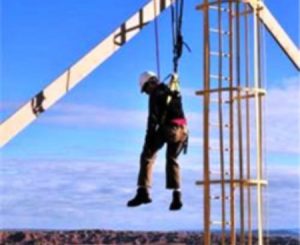 When a worker is suspended in a fall harness, the body has no way of going horizontal. The blood keeps pooling and cannot flow properly. This is suspension trauma. And unless the worker is rescued promptly, venous pooling and orthostatic intolerance occurs. This may result in serious damage to the brain, kidneys, and other organs.
When a worker is suspended in a fall harness, the body has no way of going horizontal. The blood keeps pooling and cannot flow properly. This is suspension trauma. And unless the worker is rescued promptly, venous pooling and orthostatic intolerance occurs. This may result in serious damage to the brain, kidneys, and other organs.
OSHA Recommends the Following General Practices/Considerations:
- Rescue suspended workers as quickly as possible.
- Be aware that suspended workers are at risk of orthostatic intolerance and suspension trauma.
- Be aware of signs and symptoms of orthostatic intolerance.
- Be aware that orthostatic intolerance is potentially life threatening. Suspended workers with head injuries or who are unconscious are particularly at risk.
- Be aware of factors that can increase the risk of suspension trauma.
Rescue:
If a worker falls and the force of the impact is great enough, the worker may pass out. In this case, the worker would not be able to deploy the trauma straps and will be left hanging in his harness, without leg support, until help arrives. Because of this, it is important to have a rescue plan in place.
A SINGLE FALL CAN END IT ALL!!
Download flyer: STOTW_706_Suspension Trauma After the Fall Download Spanish flyer: STOTW_706_Suspension Trauma After the Fall_esp

